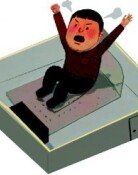A rare photo of royal palace taken during the Korean Empire
A rare photo of royal palace taken during the Korean Empire
Posted February. 15, 2017 07:04,
Updated February. 15, 2017 07:12

A rare picture of the Hoisang building of the Gyeonghui Palace under the Korean Empire was included in the document with donations from Pricilla Welbon Ewy, 80, which was recently released by the National Folk Museum of Korea. It is the only picture of that time as the building was lost in fire in the 1930s. The Japanese colonial rule set up Gyeongseong Middle School in the Gyeonghui Palace in 1911 right after the forced annexation of Korea by Japan and used the building as teachers’ dormitory of a temporary elementary school. The building was later used as an office for Japanese inspectors in the 1930s. As King Gojong mostly resided in the Gyeongbok Palace and the Gyeongun Palace, the Gyeonghui Palace was relatively less cared about. Some of the Gyeonghui palace was dissembled to obtain materials for the reconstruction of the Gyeongbok Palace between 1865 and 1868. “This appears to be why the surroundings of the Hoesang building were not managed well in the picture," said a source from the National Folk Museum of Korea.
This picture was owned by Sadie Welbon, a missionary at the end of the Korean Empire and Ewy’s grandmother when she was alive. She married to Arthur Welbon, who was sent to Korea as a missionary like her, and gave birth to Henry Welbon who served as an interpreter under the U.S. military army government in Korea. Ewy donated a total of 648 items including photos taken during the Korean Empire and documents collected by Henry Welbon to the National Folk Museum of Korea. They are historical data vividly showing the era of the end of the Korean Empire and after Korea’s independence from the perspective of the three generations of Americans who have a strong tie with the Korean Peninsula.
.
Most notable are documents of Henry Welbon who was appointed the information manager and public information officer in South Gyeongsang Province in July 1946. His primary mission was to gather Koreans’ public opinion and promote the policy of the U.S. army government. For example, his document titled “Korean rice for Koreans” promises that rice harvested in Korea will be given only to Koreans. It says that rice produced in Korea is not sent outside Korea by the military government, appealing to people not to distribute it illegally in the black market. It appears to assuage the public after the October protest sparked by their anger about the US military government’s food policy.
“The purchase price of rice was far lower than the price traded in the black market due to the extremely high inflation,” the museum said on the document. “Appealing to Korean farmers for patriotism would not have reaped strong results.”
Sang-Un Kim sukim@donga.com







